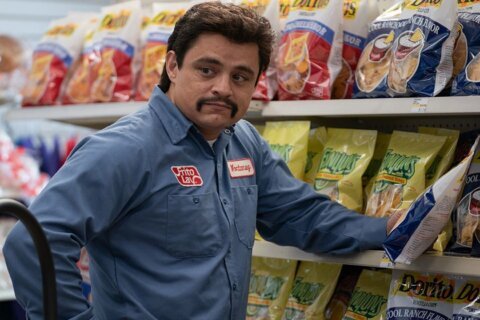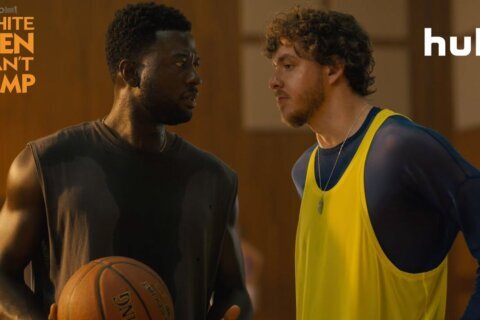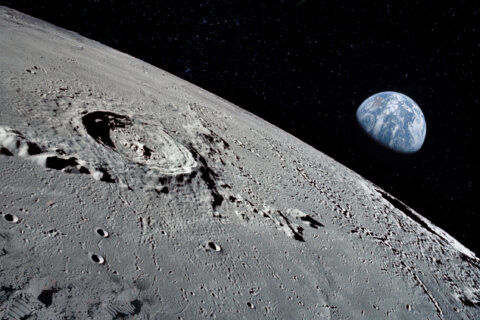Jason Fraley, WTOP film critic
WASHINGTON – Destined to become the year’s most controversial movie, “Django Unchained” is the latest effort from the Oscar-winning, envelope-pushing, culture-shaping writer/director Quentin Tarantino.
Despite directing an episode of “Four Rooms” (1995) and half the double-feature of “Grindhouse” (2007), Tarantino has only directed a handful of standalone features: “Reservoir Dogs” (1992), “Pulp Fiction” (1994), “Jackie Brown” (1997), “Kill Bill: Vol. 1 & 2” (2003-04) and “Inglourious Basterds” (2009). Even a cursory knowledge of these will tell you whether you can stomach “Django,” a film that’s equally hilarious and horrific, laced with Peckinpah-style violence, “Blazing Saddles” comedy and symbolic blood splatter on cotton fields.
There’s a dark side to pushing this envelope. After the movie theater massacre in Aurora, Colo., a phony Tweet credited the tragedy to “Basterds,” which culminates in the fiery assassination of Hitler and other Nazis in a Paris movie theater. Similarly, “Django” arrived just weeks after the massacre at Sandy Hook Elementary. As such, many liberals will detest the film’s over-the-top gun violence, while conservatives will see it as further proof of an increasingly vulgar pop culture. “Django” is an equal opportunity offender, flaunting the First and Second Amendment as the politically-incorrect version of “Lincoln.”
The plot follows African American slave Django (Jamie Foxx), who’s freed from bondage by the wily and wealthy Dr. King Schultz (Christoph Waltz), a German-speaking bounty hunter looking for a partner. Django and Schultz masquerade as slave and slave owner in an attempt to free Django’s long-lost wife Broomhilda (Kerry Washington) from the brutal Mississippi plantation owner Calvin Candie (Leonardo DiCaprio) and his happy house slave Stephen (Samuel L. Jackson).
From top to bottom, “Django” serves as a companion piece to “Inglourious Basterds,” borrowing its title from Sergio Corbucci’s 1966 western just as “Basterds” borrowed its from Enzo Castellari’s 1978 war flick. Stylistically, both feature Tarantino’s trademark genre-mashing to mock white supremacist attitudes. While “Basterds” told a revenge tale of Jewish “Apaches” scalping Nazis in German- occupied France, “Django” blends the spaghetti western with the blaxploitation flick, replacing the Nazis with southern plantation owners and swapping the Jewish rebels for African American slaves.
If you’re any good at tracking a director’s auteur themes, you could have seen “Django” coming from a mile away. When Bruce Willis turned back to save Ving Rhames from a hillbilly rapist in “Pulp Fiction,” he stood in front of a half-Confederate, half-American flag. “Jackie Brown” was envisioned as a comeback for “Foxy Brown” star Pam Grier, as much a fixture in the black community as Shaft or Super Fly. And “Basterds” not only had a black projectionist light the match on the Nazis, it also featured a German officer playing a guessing game where he mistook “King Kong” clues as the “Negro experience in America,” both stolen from native lands and brought to America in chains.
The most enjoyable crossover is Waltz, who won an Oscar as Colonel Hans Landa in “Inglorious Basterds.” In “Django,” he once again steals the show as a German, forming a buddy team with Foxx that recalls the hilarious banter between Gene Wilder and Cleavon Little in “Blazing Saddles” (1974).
Foxx may have been the only one to pull off Django’s blend of the profound and the profane, bringing the Oscar-winning clout of Denzel Washington and a hip-hop edge unbecoming of Will Smith. Kerry Washington makes a heartbreaking “Damsel in Distress,” while Leo DiCaprio and Sam Jackson make stunning heel turns, particularly as Leo reveals the skull of his grandfather’s house slave.
As expected, “Django” is ripe with racial controversy. Spike Lee refuses to watch it, tweeting: “American Slavery Was Not A Sergio Leone Spaghetti Western. It Was A Holocaust.” Likewise, I was extremely uncomfortable with Tarantino’s constant use of the “N” word. I’d prefer we bury the word forever, from stand-up routines to rap lyrics, only to unearth it in rare moments of ugly depiction (i.e. “Lincoln”) rather than a routine punchline. Tarantino seems intent on breaking a record.
As Biggie notoriously said, “If you don’t know, now you know.” The question then becomes: why the frequency? To remind us of its ugliness? To be historically accurate in the pre-Civil War south? Or to be purposely controversial? Whatever the reason, I can absolutely see folks walking out of the theater under the barrage of such a painful word. Still, if you stay until the end, you’ll realize the film’s underlying moral arc is just, epitomized in a scene mocking the KKK, recalling the best skits of Dave Chappelle and landing the funniest scene of the year.
Aside from the Coen Brothers, Tarantino may be the only current writer/director nimble enough to walk the tightrope of comedy and violence. In “Django,” his violence is either: (a) artfully done, like a horse galloping in slow-motion as a dead man falls off; (b) so stylized as to appear cartoonish; (c) left largely off- screen, like a slave getting ripped apart by dogs; (d) revealed in quick acid flashbacks that serve more as painful reminders than bloody reality; or (e) visually suggested by way of whip marks.
It’s easy to say film violence has worsened in today’s age of “Saw” torture porn, but generations of masterpieces have invoked it. The ’60s brought the bloody ballets of Arthur Penn’s “Bonnie and Clyde” (1967) and Sam Peckinpah’s “The Wild Bunch” (1969); the ’70s brought Francis Ford Coppola’s “The Godfather” (1972) and Martin Scorsese’s “Taxi Driver” (1976); while the ’80s brought Brian De Palma’s “Scarface” (1983). The path of destruction was well on its way by the time Tarantino arrived with “Reservoir Dogs” and “Pulp Fiction” in the ’90s. Where would film history be without these filmmakers? Where do we draw the line between massacre and masterpiece? And how does cinema impact culture compared to the vicarious nature of first-person shooter video games?
The debate rages as an issue to be decided by parents, voters and lawmakers. As a film critic, the most egregious excess of “Django” was not the violence or language, but rather the 2:45 runtime, as Tarantino absolutely should have trimmed the last 45 minutes. Around the two-hour mark, the villain is defeated in a giant gun battle at the Candieland Plantation, leaving us ready for an Act Three resolution. Instead, Tarantino introduces a nude torture scene and an unnecessary cameo revealing the overweight director, all en route to a second gunfight at the same plantation.
Nothing exceeds like excess, and the repetition of “Django” hamstrings a potential masterpiece. Which brings us back to the aforementioned skull scene. In a moment of villainous ignorance, DiCaprio holds a slave skull, explaining how blacks have indents on the submissive side of the brain, while whites like Galileo have indents on the creative side. The metaphor works just as well for Tarantino, his brain firing off flurries of creative genius, but needing to be harnessed. The Weinsteins are willing to give him “cart blanche” because he practically built their company, but the editing room could be his friend.
Overall, “Django Unchained” remains an off the hook theater-going experience, as uncomfortable as it is entertaining, yet utterly unforgettable. It was released on Christmas Day alongside Tom Hooper’s “Les Miserables,” where the shooting of a child made me cringe with “too soon” anxiety more than anything from Tarantino. Instead, I left “Django” with the lyrics of “O Holy Night” echoing across the holiday season: “Chains shall he break, for the slave is our brother.”
★ ★ ★ 1/2
The above rating is based on a 4-star scale. Follow WTOP Film Critic Jason Fraley on Twitter @JasonFraleyWTOP or check out his blog The Film Spectrum.








